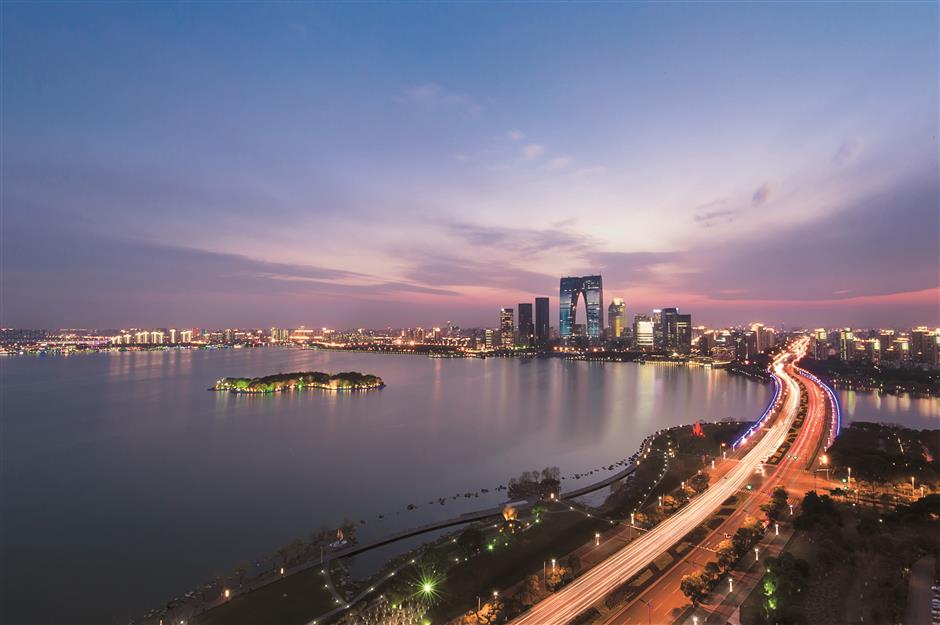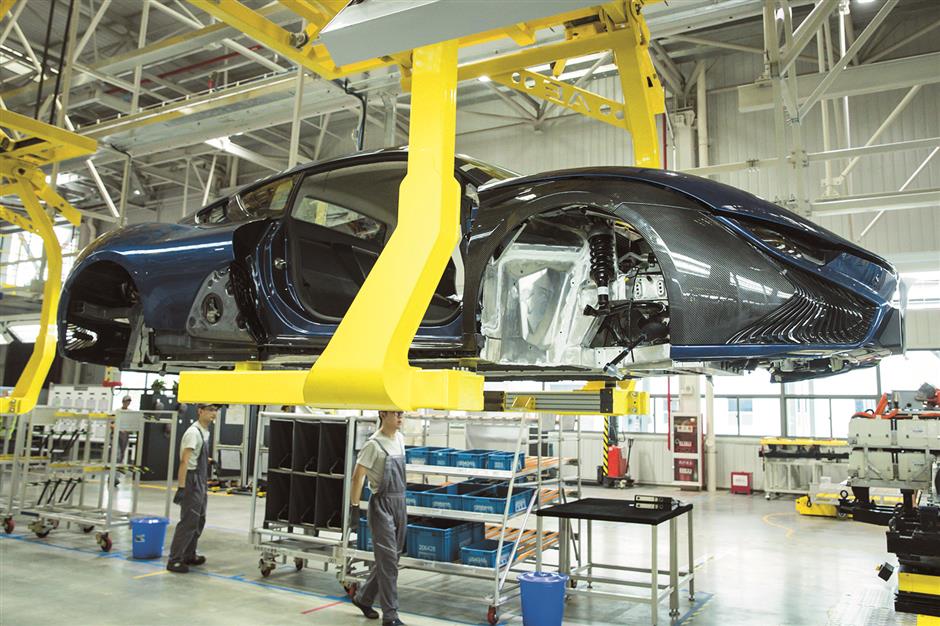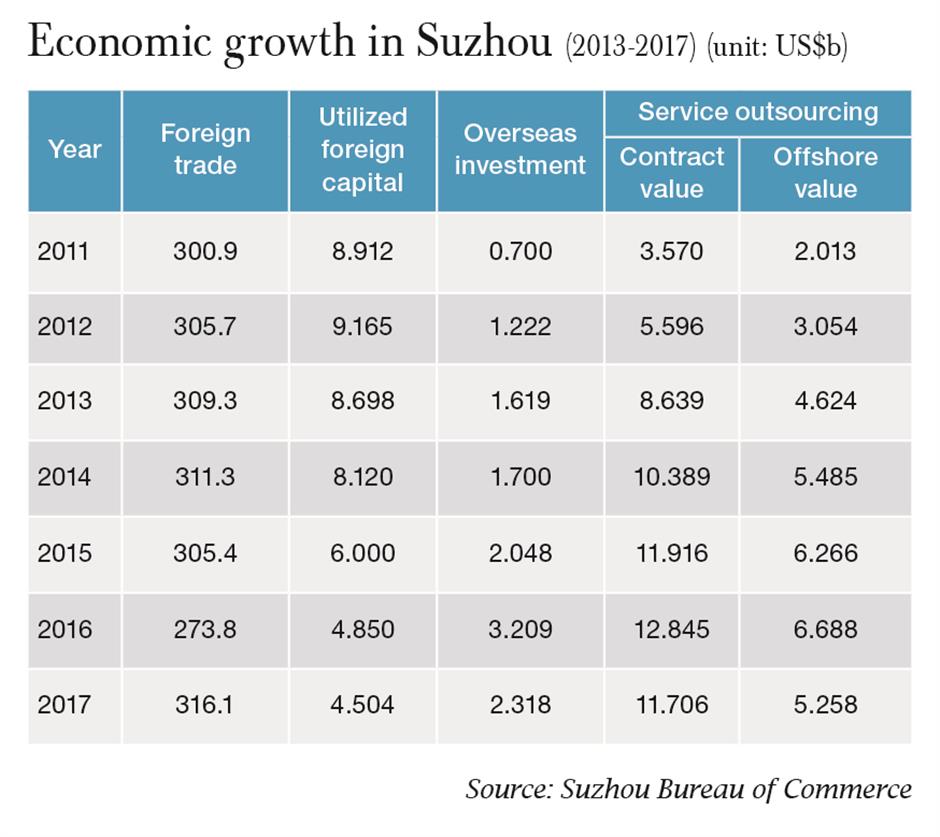Opening up an economic success story
Suzhou has achieved impressive economic development over the 40 years of reform and opening-up and is further pushing forward the open economic structure optimization, transformation and upgrading.
Suzhou has stood firm in the tide of reform and opening-up with its solid steps in transformation and upgrading, and opening-up and innovation.
The city’s open economy has played an important role and made tremendous contributions in urban construction, social progress and improving people’s livelihoods.
Over the past 40 years, Suzhou’s economy has posted robust growth, with the gross domestic product of the city surging by 13.3 percent a year on average. The figure was 3.7 percentage points higher than the national average.
The city’s import and export volume has remained fourth in the country for a long time, after Shenzhen, Shanghai and Beijing. The export has remained third, following Shenzhen and Shanghai. The cumulative actual use of foreign capital ranked second after Shanghai, and the city’s overseas investment has maintained its top position for 14 years in a row.
The city’s degree of dependence on foreign trade, an indicator of trade openness, stood at 126 percent, as the open economy has been playing a strong driving role for a long time.
In 2017, Suzhou’s total GDP took a bump up to 1.73 trillion yuan (US$250 billion) from 3.19 billion yuan in 1978, ranking seventh in the country.
The total import and export volume of the city reached US$316.08 billion in 2017, a year-on-year increase of 15.5 percent, of which the scale reached a record high and the growth pace was 4.1 percentage points higher than the national level.
Other main development indicators such as the total industrial output value above designated size, local public budget revenues and fixed-asset investment above designated size are respectively ranked the second, sixth and 11th of the country’s large and medium-sized cities.
Among them, 70 percent of total industrial output value, 60 percent of GDP, 35 percent of fixed asset investment and more than 2.6 million jobs were directly contributed by the open economy.
By the end of 2017, a total of around 17,000 foreign-funded enterprises, more than 280 foreign-funded regional headquarters and 28,000 foreign trade companies had been set up in Suzhou.

Jinji Lake
With less than 0.1 percent of the country’s land and 0.8 percent of the population, Suzhou achieved a volume of import and export accounting for 7.7 percent of the nation.
It also contributed 8.27 percent of exports in the country and 3.44 percent of actual use of foreign capital.
These figures indicated that the open economy has gradually become the calling card of Suzhou, and has also become an important support for the city’s economic and social development.
Meanwhile, depending on the strong driving force of the open economy, Suzhou has been actively engaged in exchanges with foreign countries in various fields including science, technology, culture and sports, and the city’s internationalization has been continuously promoted.
For instance, Suzhou has more than 30 international scientific and technological cooperation carriers, and over 90 percent of large and medium-sized foreign-invested enterprises had established research and development centers in the city as of 2017, and the number of foreigners who had lived in Suzhou for at least one year reached over 50,000.
The development of the open economy has also led to the liberation of thoughts and the renewal of ideas, promoted the formation of the market economy, and effectively promoted the concentration of innovative elements in aspects including talent, technology and industry, thus laying a solid foundation for the city to carry out the innovation-driven strategy and promote the broader and deeper opening-up.
The number of research and development centers, R&D personnel and the amount of investment on R&D at foreign-funded enterprises account for more than 50 percent of the city’s total. And the number of patent applications by foreign companies a year accounts for about 12 percent of that of all companies in the city.
The development zones in Suzhou are gathering innovative resources, with over 80 percent of high-tech enterprises, more than 95 percent of technologically advanced service enterprises, and 80 percent of foreign-invested independent R&D centers in the city being located in the development zones.
The open economy has also played an active role in promoting the progress of social civilization. The orderly entry of foreign capital into new business forms, upgrading of traditional service industry, protection and reconstruction of ancient cities, environmental protection, finance and other public services have effectively promoted the internationalization, equalization and modernization of public services and directly promoted the improvement of people’s living standards.
Among the city’s open economy progress over the past four decades, the 1990s marked its accelerated development phase, starting from the development and opening-up of Shanghai’s Pudong area in 1990, till China’s joining the WTO in 2001.
During this period, Suzhou concentrated its efforts on setting up development zones of national and provincial level, aiming to optimize the economic structure, to develop superior technology, to pilot the market economic system, and to carry out all-round opening-up.
From 1991 to 2000, Suzhou had cumulatively built five national-level development zones and 10 provincial-level development zones, among which the most representative are Suzhou New District and Suzhou Industrial Park.

Workers assemble Qiantu K50 electric roadsters on the assembly line at the auto plant of Qiantu Motor in Suzhou.
Boosted by the development zones, Suzhou posted the actual use of foreign capital hitting US$2.88 billion in 2000 and import and export volume leaping to US$20 billion, which were respectively 35 times and 52 times the figures in 1991.
And in the years from 2001 to 2010, the actual use of foreign capital in Suzhou had increased by 1.8 times, the total volume of import and export jumped 10.6 times, and the scale of overseas investment had expanded by 165 times, making the decade another period of rapid expansion.
Saying that the biggest feature of the city’s open economy development before 2010 was “fast,” starting from 2011, Suzhou’s open economy has entered the “new normal” stage characterized by medium-to-high speed, structure optimization, new momentums, multiple challenges and rebalancing.
From 2011 to 2017, the growth rates of Suzhou’s foreign trade were generally lower than the national average level, and its actual use of foreign capital posted an obvious down trend in scale.
Despite the moderate growth of overall imports and exports, the proportion of general trade and the proportion of the service industry’s utilization of foreign capital in the city were both rising rapidly in recent years. The “going out” strategy, service outsourcing and service trade also posted robust development.
Innovative businesses such as cross-border yuan, cross-border e-commerce, trade diversification, global maintenance, financing and leasing, and tax refund for port of departure have been approved for launching pilot projects, indicating that Suzhou is further pushing forward the open economic structure optimization and the transformation and upgrading.
Looking back on the process of attracting foreign investment in the past 40 years, foreign investors have been paying great attention to Suzhou not only for its regional and cost advantages, but more in consideration of the policies and plans by governments at all levels in the city.
Suzhou has been laying great emphasis on improving the business environment, offering excellent services for foreign businesses, and launching innovative plans and policies on opening-up, thus achieving common development for both the city and foreign companies.

China-Singapore forum to focus on cooperation in service trade innovation
China-Singapore Forum on Cooperation in Service Trade Innovation, a parallel session of the China International Import Expo, will open on November 7 at InterContinental Shanghai Hongqiao NECC to share insights into the global development trend of service trade in the age of digital economy.
The forum is sponsored by China’s Ministry of Commerce, Singaporean Ministry of Trade and Industry and Jiangsu Provincial government and organized by Suzhou municipal government and Suzhou Industrial Park Administration Committee.
As the only CIIE session themed in China-foreign cooperation in service trade, the forum is aimed at promoting innovation and cooperation in service trade industry in the new stage of economic globalization.
At the forum, attendees can listen to several important speeches, including “Development of China’s Service Trade in the Era of High-level Global Connectivity” by Jiang Xiaojuan, professor of the Chinese Academy of Social Sciences, and “WTO and Open Development of Chinese Services” by Long Yongtu, co-chairman of Global CEO Conference, former vice minister for trade and a top trade negotiator.
Besides, China Service Trade Innovation and Development Guide Fund and SIP Administration Committee will announce strategic cooperation at the forum.


















